Tuesday, July 13th 2021
Jonsbo Introduces the N1 Mini-ITX Chassis
Jonsbo has added to their PC case lineup with the introduction of the N1 Mini-ITX chassis. The N1 features a minimalist, industrial design thanks to its external brushed aluminium enclosure (3 mm) and steel innards (1 mm thick), and includes four feet so the tower can be put in vertical position, in addition to its apparently stock, horizontal one. The Jonsbo N1 features 5x 3.5" expansion bays, and 1x low-profile PCIe expansion port.
A single 140 mm fan on the front of the unit helps keep temperatures in check (particularly for the HDDs), and there's naturally support for a SFF power supply (up to 150 mm in length). The CPU cooler has clearance for up to 70 mm, and the graphics card support is limited to 185 mm. The front panel offers 1x USB 3.0, 1x USB Type-C, and 1x audio port. No word on pricing was available at time of writing.
A single 140 mm fan on the front of the unit helps keep temperatures in check (particularly for the HDDs), and there's naturally support for a SFF power supply (up to 150 mm in length). The CPU cooler has clearance for up to 70 mm, and the graphics card support is limited to 185 mm. The front panel offers 1x USB 3.0, 1x USB Type-C, and 1x audio port. No word on pricing was available at time of writing.
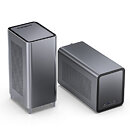
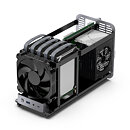
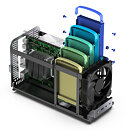
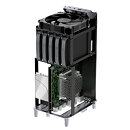
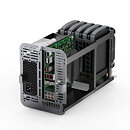
18 Comments on Jonsbo Introduces the N1 Mini-ITX Chassis
Admittedly most NAS appliances rely on a single fan, but it's usually a pull fan in the rear.
Not sure I would consider the sidegrade, as I managed to squeeze in a 120mm AIO liquid cooler in my NAS case and that wouldn't fit in this.
It's also not obvious how the SATA backplane connects to the motherboard.
- Solid front panel for the single intake fan?
- 5x 3.5" bays instead of 4x means no real gap between drives for airflow
- Vertical orientation has the heaviest part (disks) at the top for instability.
- Vertical orientation has the most temperature-sensitive part (disks) at the top, fighting convected heat from the CPU and PSU.
- CPU heatsink orientation (likely irrelevant as people will provide their own CPU cooler, but still shows lack of thermal design understanding from Jonsbo)
Make the product, take an actual photo of what you can deliver, and THEN we can either dismiss it or get excited about it.- Its small lower power NAS, you don't need a ton of air flow just some venting and active air movement.
- The drives have a 140mm fan right in front of them and thats how all enterprise NASs stack their drives.
- Yeah, thats an odd choice.
- Unless you are using 10k drives hard drives hardly use any power once they are spun up and with a 140mm fan there is plenty of cooling for them.
- Its not that Jonsbo dosn't understand thermals its just that like you said it just dosn't make any difference, you'll need active cooling unless you are going to use a ~10 watt CPU. The passive heatsink in the render isn't meant to be taken literally its just to show the layout of components.
Build quality looks exceptional and the design isn't perfet but I think its pretty nice case for small home NAS that you don't want to hide away in a closet.Hopefully they will get some good feedback & address them, then come out with a superior, redesigned product, fingers crossed :)
Also, if you look at the front, it has about a centimeter wide air-intake around the edge of that "solid" front panel. Maybe not ideal, but it's clearly not solid.
I can agree with the second point, but again, look at the picture I posted, it doesn't look that bad.
I would guess putting the drives in the front was using the logic of every NAS having the drives up front and then nothing thinking any furter.You'd be surprised how much airflow you need in hotter climates.
Built my own NAS and I had to put in a second fan to get some airflow over the drives, as it simply wasn't enough air going through the rather crappy hot-swappable case I got. There are sadly not a ton of options when it comes to DIY NAS cases.
Enterprise NAS appliances also have a lot higher speed fans in them, as they push a lot more air through the case and don't care about noise levels.
The fan is meant for the hard drives. None if any of the airflow is going to make it to the heatsink.
The drives normally idle around 45 degrees in summer, which is still hot for idle drives imho.
One 140mm fan has an external frame dimension of 140x140mm. The actual fan blades have like 133mm diameter - so we have a 133mm fan trying to blow air through a wall solid wall of hard disks with four gaps that are, assuming things are evenly-spaced in that 140mm wide cage, only 1.6mm wide. (140mm-130.5mm)/6
In other NAS and high-density storage servers, there is either far more spacing for airflow - around 5-10mm, or else they use 5000RPM high-pressure screamy boys to ram air through the tiny gaps, eardrums be damned.I don't think there are any 10K SATA drives on the market any more. 10K SAS, sure - but this isn't a SAS backplane, it's a SATA backplane.
The 140mm in this would be fine, there just needs to be some air moving past the drives. Yeah the drive in the middle right behind the fan motor is going to run hotter than the others no doubt but it should still be fine.
The 2U 8 bay Supermicros I've worked in have 3 80mm fans as well and and its just the one system on its own outside of a hot rack those systems stay very reasonably quiet. The fans have very high top end but they are temp controlled and aside from initial power on I've never heard them come anywhere near that top speed. A NAS dosn't need that much air flow, they should have the capacity for it if cooling in the rack or row has an issue but under normal conditions they should be pretty quiet. Compute hosts on the other hand.... yeah those are loud.